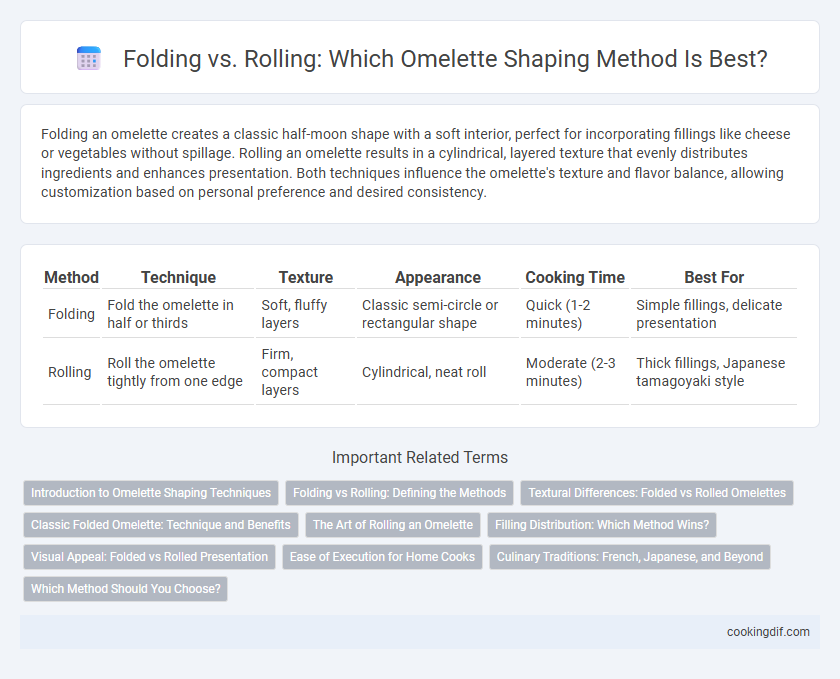Folding an omelette creates a classic half-moon shape with a soft interior, perfect for incorporating fillings like cheese or vegetables without spillage. Rolling an omelette results in a cylindrical, layered texture that evenly distributes ingredients and enhances presentation. Both techniques influence the omelette's texture and flavor balance, allowing customization based on personal preference and desired consistency.
Table of Comparison
| Method | Technique | Texture | Appearance | Cooking Time | Best For |
|---|---|---|---|---|---|
| Folding | Fold the omelette in half or thirds | Soft, fluffy layers | Classic semi-circle or rectangular shape | Quick (1-2 minutes) | Simple fillings, delicate presentation |
| Rolling | Roll the omelette tightly from one edge | Firm, compact layers | Cylindrical, neat roll | Moderate (2-3 minutes) | Thick fillings, Japanese tamagoyaki style |
Introduction to Omelette Shaping Techniques
Folding and rolling are two popular techniques for shaping omelettes, each affecting texture and presentation. Folding creates a layered, fluffy interior ideal for soft fillings, while rolling offers a sleek, uniform cylinder often used in Japanese tamagoyaki. Mastering both methods enhances culinary versatility and allows chefs to tailor omelette dishes to diverse preferences and cuisines.
Folding vs Rolling: Defining the Methods
Folding an omelette involves gently bending it over itself to create a soft, layered texture often seen in French-style omelettes, preserving a creamy interior. Rolling an omelette requires tightly wrapping the egg mixture into a cylindrical shape, commonly used in Japanese Tamagoyaki for a firmer, uniform consistency. Understanding these distinct techniques enhances control over texture and presentation, catering to diverse culinary preferences.
Textural Differences: Folded vs Rolled Omelettes
Folded omelettes showcase a tender, slightly airy texture due to the gentle layering, which allows for a soft, custard-like interior. Rolled omelettes create a denser, more uniform texture by tightly coiling the egg, resulting in a smooth, compact consistency. The distinct textural differences between folded and rolled omelettes influence mouthfeel and flavor integration, making folding ideal for lighter dishes and rolling suited for hearty fillings.
Classic Folded Omelette: Technique and Benefits
The classic folded omelette technique involves gently cooking beaten eggs until partially set, then folding them over fillings like cheese, herbs, or vegetables to create a tender, fluffy texture. This method preserves the omelette's lightness and allows for even distribution of ingredients, resulting in a balanced flavor profile and appealing presentation. The folded omelette also offers ease of customization and quick preparation, making it a popular choice in both home kitchens and professional settings.
The Art of Rolling an Omelette
The art of rolling an omelette involves a precise technique where the cooked egg is gently lifted and folded over itself, creating a smooth, cylindrical shape that retains a fluffy texture. This method enhances the omelette's visual appeal and allows for even cooking, while preserving fillings inside without spillage. Mastering the rolling technique requires using a non-stick pan and proper timing to achieve a tender, neatly enclosed omelette.
Filling Distribution: Which Method Wins?
Folding an omelette ensures even filling distribution by gently encasing ingredients, preventing spillage and promoting balanced bites with each forkful. Rolling tends to concentrate fillings towards the center, potentially causing uneven texture and flavor throughout the omelette. For consistent filling distribution and optimal taste experience, folding emerges as the superior shaping method.
Visual Appeal: Folded vs Rolled Presentation
Folding an omelette creates a classic, neat half-moon shape with a smooth surface that showcases a uniform texture and often a visible filling peek, enhancing its visual appeal. Rolling produces a cylindrical, layered appearance emphasizing the eggs' fluffiness and the ingredients inside, offering a more dynamic presentation with distinct spirals. Both techniques highlight different aesthetic qualities, with folding favoring simplicity and elegance, while rolling emphasizes complexity and depth.
Ease of Execution for Home Cooks
Folding an omelette offers greater ease of execution for home cooks due to its simple, quick technique that requires minimal skill and equipment, making it ideal for beginners. Rolling an omelette demands more precision and practice to achieve a smooth, uniform shape, often needing a non-stick pan and specific tools like a spatula or chopsticks. Consequently, folding is a more accessible method for everyday cooking, minimizing the risk of tearing or uneven cooking.
Culinary Traditions: French, Japanese, and Beyond
French omelettes are traditionally folded to create a tender, smooth texture with a slightly creamy interior, emphasizing delicate shaping techniques. Japanese tamagoyaki employs a rolling method, layering thin egg sheets to achieve a sweet, compact, and visually appealing cylindrical form. Beyond these, various culinary traditions adapt folding or rolling to balance texture, flavor infusion, and presentation, highlighting regional cooking styles and ingredient uses.
Which Method Should You Choose?
Folding an omelette creates a soft, tender texture with visible layers, ideal for incorporating delicate fillings like herbs and cheese. Rolling produces a denser, uniform shape that seals in ingredients such as vegetables or meats more securely, making it suitable for portable or handheld servings. Choose folding for a traditional presentation and mild fillings, and rolling for a compact, sturdy omelette that holds robust flavors well.
Folding vs Rolling for omelette shaping Infographic

 cookingdif.com
cookingdif.com